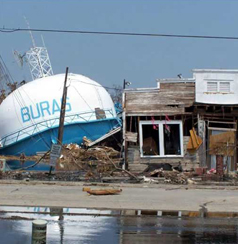
Vital Protection in a Storm
Mary Kelly - The Philadelphia Inquirer
Scientists agree that lost wetlands could have reduced Katrina's surge. To prevent future damage, we need to restore them now..
Four years ago this weekend, Hurricane Katrina, a Category 3 storm, caused massive destruction along the Gulf Coast from central Florida to Texas. Much of the damage was caused by storm surge, which destroyed infrastructure and damaged critical refineries. It also contributed to levee failures, flooding homes and small businesses on a scale that stunned even the most jaded hurricane watchers.

A fallen water tower in Buras, Louisiana, following Hurricane Katrina. (Photo: US EPA)
The severity of Katrina's damage in Louisiana was caused, in part, by the fact that the state had already lost one-third of its original wetlands - about 2,000 square miles - an area larger than Delaware. Scientists agree that these lost wetlands could have helped reduce storm surge. Healthy wetlands function as "horizontal levees" that absorb storm energy, slow incoming waves and winds, and pool surge waters. If we are to prevent similar or worse storm damage in the future, we urgently need to restore these wetlands and associated coastal forests.
This is not just Louisiana's problem. Here is what's at stake for our nation:
The more vulnerable coastal communities are to hurricane damage, the more it costs the federal government - and taxpayers - to help communities recover after a storm. Property damage from the top five Atlantic hurricanes since 1992 (Katrina, Andrew, Ike, Wilma, and Charley) totaled nearly $200 billion, only a portion of which was covered by private insurance.
Coastal Louisiana is home to critical energy-production infrastructure and the busiest port in North America by volume. Disruption of these industries because of storm damage ripples through the national economy.
Coastal wetlands provide protection and are home to huge commercial and recreational fisheries. As land along the Louisiana coastline disappears, so does the rich habitat that supports the most valuable fishery in the Gulf, as well as vast populations of migratory birds.
Despite these facts, the U.S. Army Corps of Engineers isn't expected to complete the design and engineering work for the restoration projects east of New Orleans that were authorized by the Water Resources Development Act until March 2011. This area includes the Lower Ninth Ward and St. Bernard Parish, where the storm surge wreaked havoc. The congressionally mandated deadline for this area was May 2008.
Without a completed plan, the Corps cannot seek funding from Congress to rebuild the wetlands and cypress forests needed to protect these sections of New Orleans.
We need an unequivocal commitment from the Corps and other responsible agencies that they won't let outdated bureaucratic procedures stand in the way of necessary action.
The Corps must bring a renewed sense of urgency to coastal Louisiana restoration, and similar projects in other Gulf Coast states. They must honor President Obama's campaign pledge "to restore nature's barriers - the wetlands, marshes, and barrier islands that can take the first blows and protect the people of the Gulf Coast."
Given the fragility of our nation's economy, this cannot become just another project. It must be a top priority, and the Corps should do everything it can to expedite restoration design and construction. The hurricanes won't wait; neither should we.
--------
Mary Kelly is senior counsel for the Center for Rivers and Deltas in the Austin office of the Environmental Defense Fund.
